Apply Basic Concepts of Sustainability to Practice: Water Conservation
VerifiedAdded on 2022/09/22
|6
|1322
|28
Homework Assignment
AI Summary
This assignment addresses the critical issue of water conservation by applying basic sustainability concepts to practical home applications. The student emphasizes the increasing scarcity of freshwater resources and the detrimental effects of pollution, particularly highlighting the need for immediate action. The assignment focuses on personal responsibility and proposes actionable strategies, such as reducing water wastage in various household activities, implementing smart home technologies like efficient washing machines and dishwashers, and utilizing smart flushes. The core solution involves rainwater harvesting as a sustainable and effective method for conserving water, discussing its implementation and benefits. The student also stresses the importance of monitoring water usage through meters to identify areas of high consumption and wastage. By adopting these measures, the assignment advocates for a conscious shift towards sustainable water management, ensuring availability for future generations. The paper includes references to support the arguments and strategies proposed.
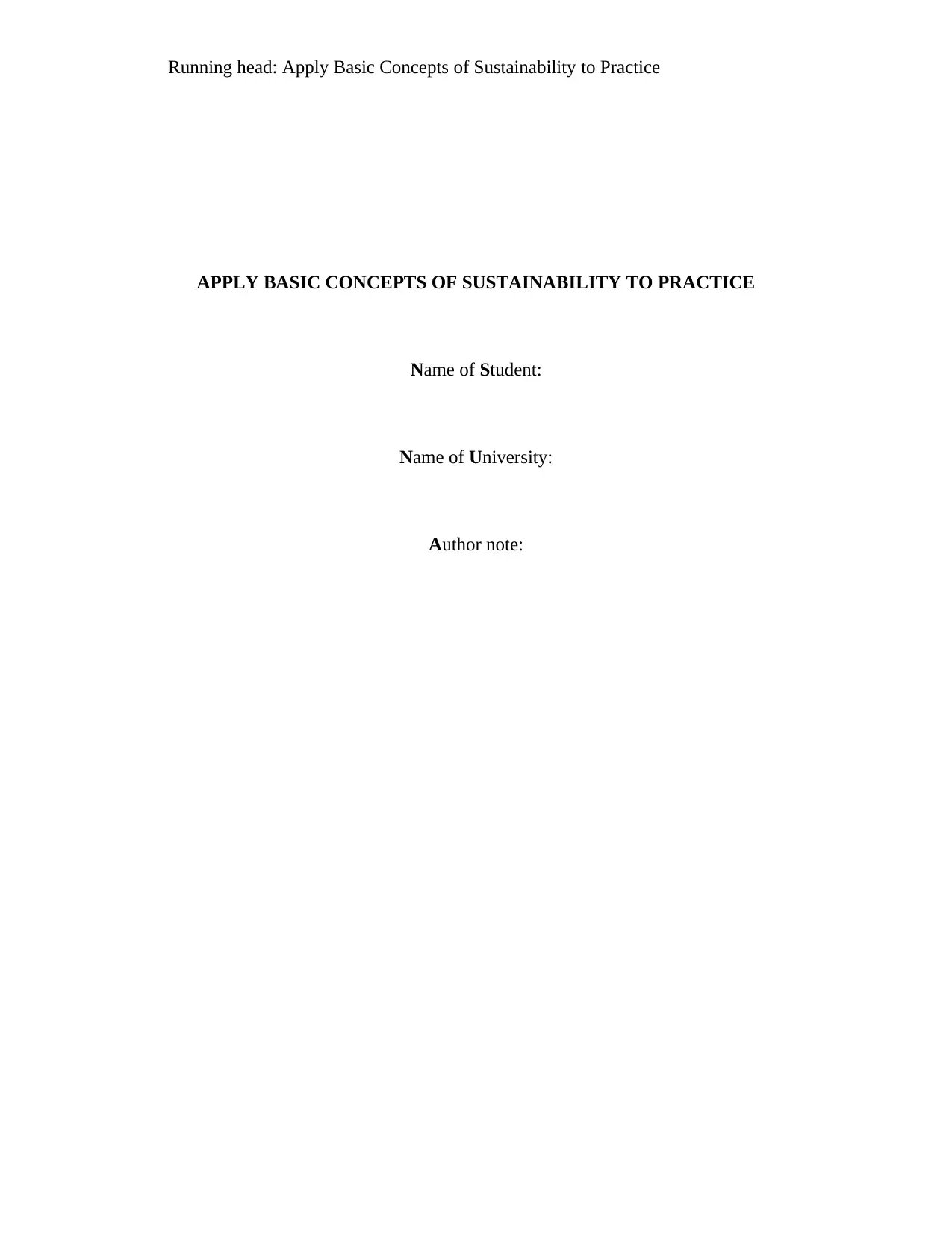
Running head: Apply Basic Concepts of Sustainability to Practice
APPLY BASIC CONCEPTS OF SUSTAINABILITY TO PRACTICE
Name of Student:
Name of University:
Author note:
APPLY BASIC CONCEPTS OF SUSTAINABILITY TO PRACTICE
Name of Student:
Name of University:
Author note:
Paraphrase This Document
Need a fresh take? Get an instant paraphrase of this document with our AI Paraphraser
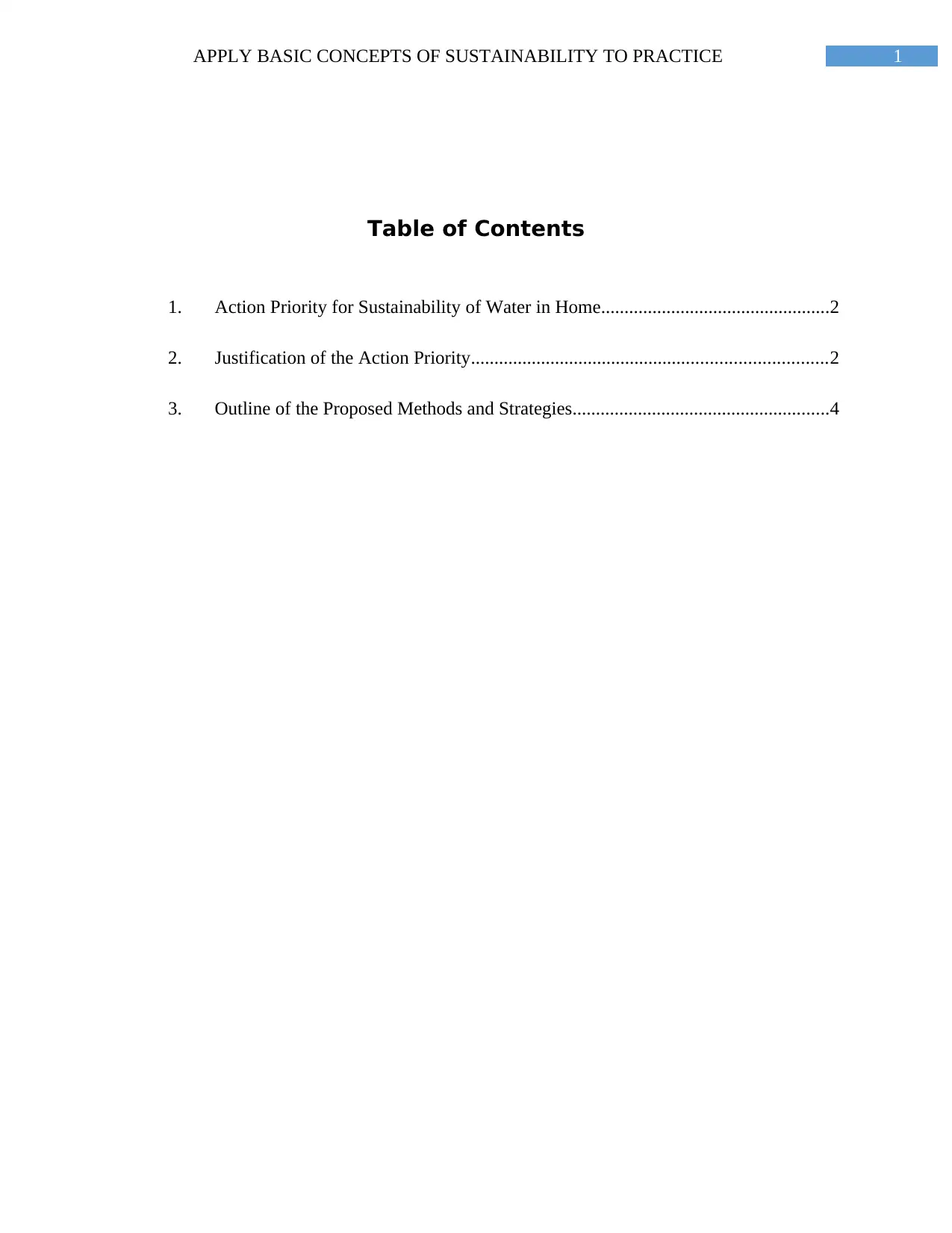
1APPLY BASIC CONCEPTS OF SUSTAINABILITY TO PRACTICE
Table of Contents
1. Action Priority for Sustainability of Water in Home.................................................2
2. Justification of the Action Priority............................................................................2
3. Outline of the Proposed Methods and Strategies.......................................................4
Table of Contents
1. Action Priority for Sustainability of Water in Home.................................................2
2. Justification of the Action Priority............................................................................2
3. Outline of the Proposed Methods and Strategies.......................................................4
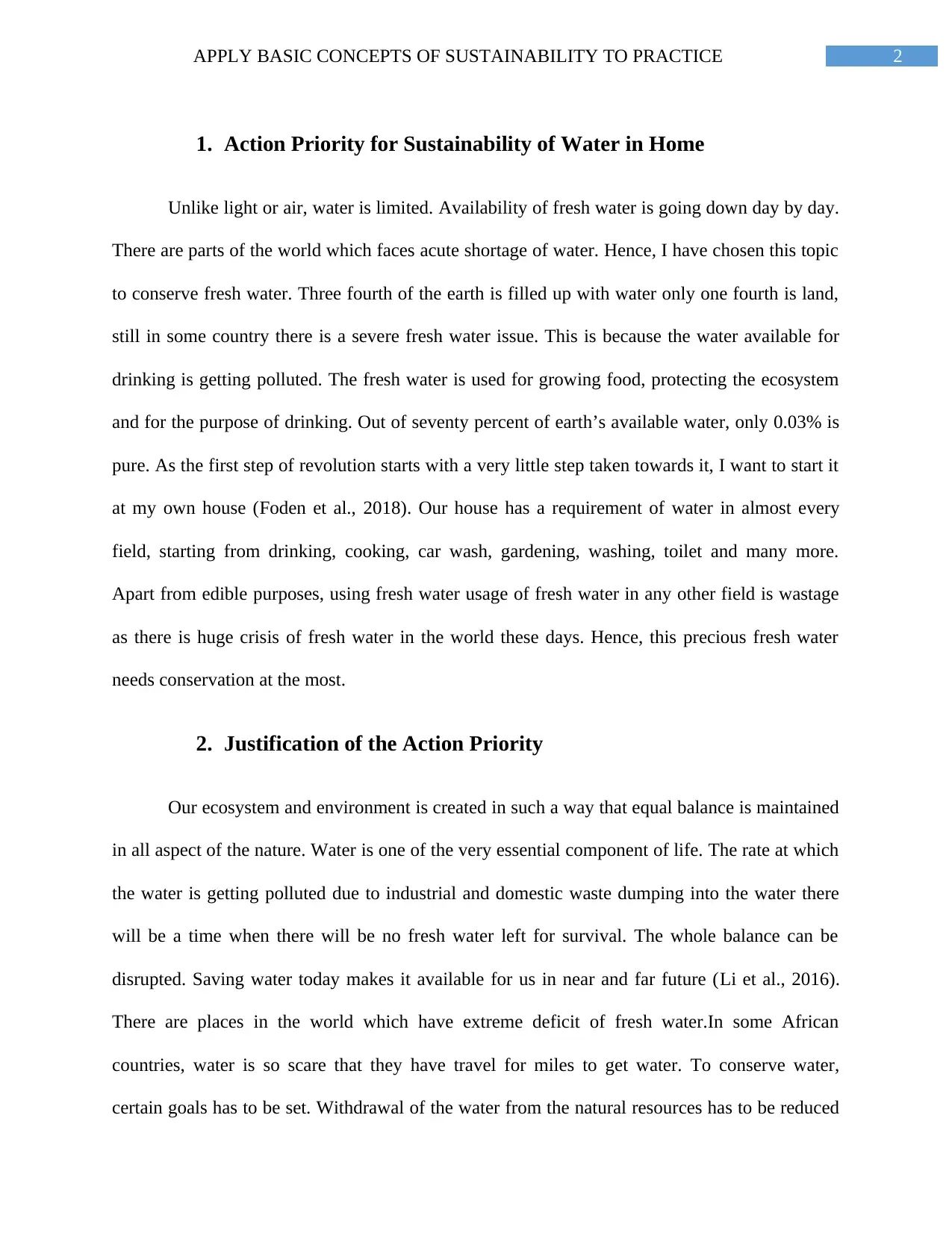
2APPLY BASIC CONCEPTS OF SUSTAINABILITY TO PRACTICE
1. Action Priority for Sustainability of Water in Home
Unlike light or air, water is limited. Availability of fresh water is going down day by day.
There are parts of the world which faces acute shortage of water. Hence, I have chosen this topic
to conserve fresh water. Three fourth of the earth is filled up with water only one fourth is land,
still in some country there is a severe fresh water issue. This is because the water available for
drinking is getting polluted. The fresh water is used for growing food, protecting the ecosystem
and for the purpose of drinking. Out of seventy percent of earth’s available water, only 0.03% is
pure. As the first step of revolution starts with a very little step taken towards it, I want to start it
at my own house (Foden et al., 2018). Our house has a requirement of water in almost every
field, starting from drinking, cooking, car wash, gardening, washing, toilet and many more.
Apart from edible purposes, using fresh water usage of fresh water in any other field is wastage
as there is huge crisis of fresh water in the world these days. Hence, this precious fresh water
needs conservation at the most.
2. Justification of the Action Priority
Our ecosystem and environment is created in such a way that equal balance is maintained
in all aspect of the nature. Water is one of the very essential component of life. The rate at which
the water is getting polluted due to industrial and domestic waste dumping into the water there
will be a time when there will be no fresh water left for survival. The whole balance can be
disrupted. Saving water today makes it available for us in near and far future (Li et al., 2016).
There are places in the world which have extreme deficit of fresh water.In some African
countries, water is so scare that they have travel for miles to get water. To conserve water,
certain goals has to be set. Withdrawal of the water from the natural resources has to be reduced
1. Action Priority for Sustainability of Water in Home
Unlike light or air, water is limited. Availability of fresh water is going down day by day.
There are parts of the world which faces acute shortage of water. Hence, I have chosen this topic
to conserve fresh water. Three fourth of the earth is filled up with water only one fourth is land,
still in some country there is a severe fresh water issue. This is because the water available for
drinking is getting polluted. The fresh water is used for growing food, protecting the ecosystem
and for the purpose of drinking. Out of seventy percent of earth’s available water, only 0.03% is
pure. As the first step of revolution starts with a very little step taken towards it, I want to start it
at my own house (Foden et al., 2018). Our house has a requirement of water in almost every
field, starting from drinking, cooking, car wash, gardening, washing, toilet and many more.
Apart from edible purposes, using fresh water usage of fresh water in any other field is wastage
as there is huge crisis of fresh water in the world these days. Hence, this precious fresh water
needs conservation at the most.
2. Justification of the Action Priority
Our ecosystem and environment is created in such a way that equal balance is maintained
in all aspect of the nature. Water is one of the very essential component of life. The rate at which
the water is getting polluted due to industrial and domestic waste dumping into the water there
will be a time when there will be no fresh water left for survival. The whole balance can be
disrupted. Saving water today makes it available for us in near and far future (Li et al., 2016).
There are places in the world which have extreme deficit of fresh water.In some African
countries, water is so scare that they have travel for miles to get water. To conserve water,
certain goals has to be set. Withdrawal of the water from the natural resources has to be reduced
⊘ This is a preview!⊘
Do you want full access?
Subscribe today to unlock all pages.

Trusted by 1+ million students worldwide
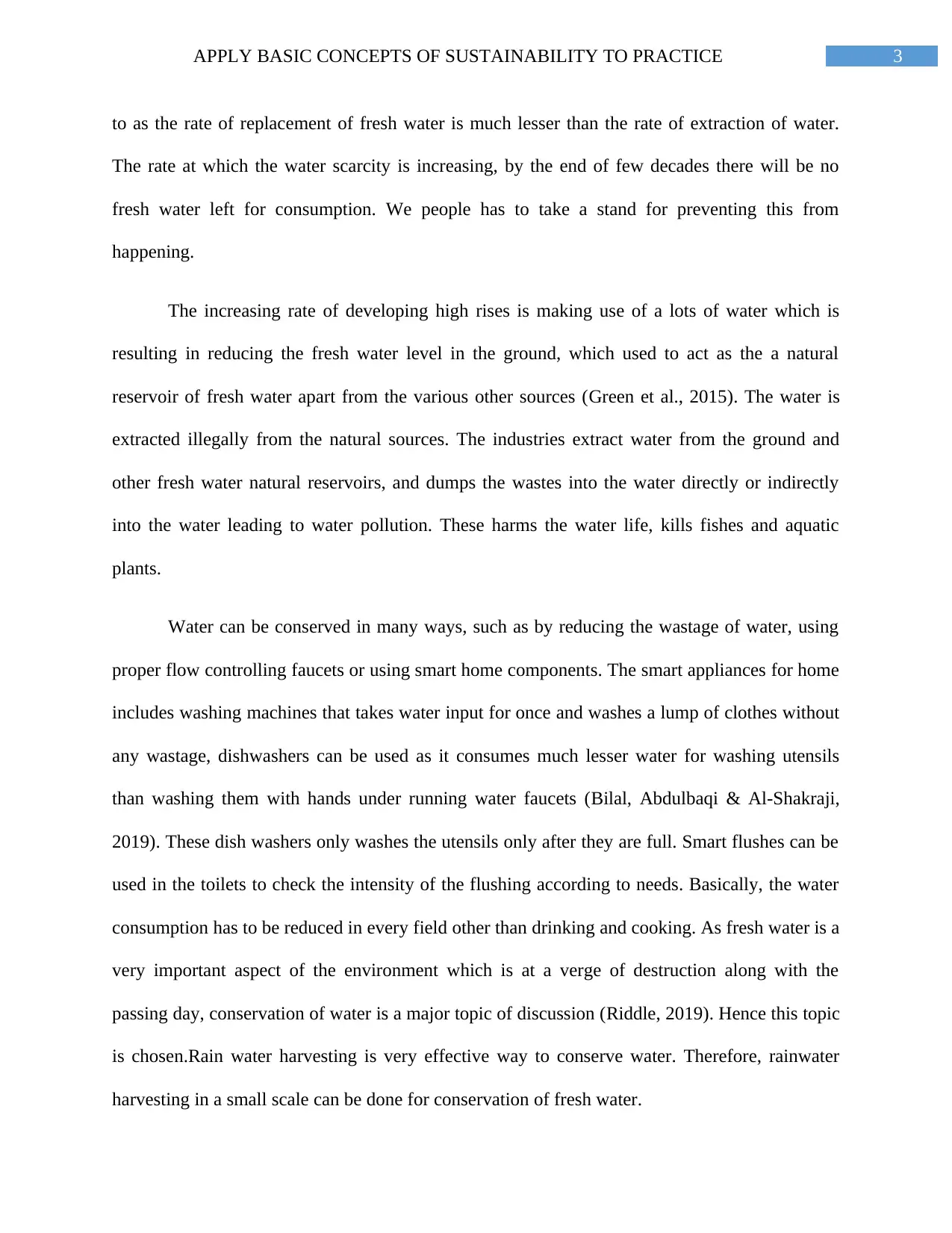
3APPLY BASIC CONCEPTS OF SUSTAINABILITY TO PRACTICE
to as the rate of replacement of fresh water is much lesser than the rate of extraction of water.
The rate at which the water scarcity is increasing, by the end of few decades there will be no
fresh water left for consumption. We people has to take a stand for preventing this from
happening.
The increasing rate of developing high rises is making use of a lots of water which is
resulting in reducing the fresh water level in the ground, which used to act as the a natural
reservoir of fresh water apart from the various other sources (Green et al., 2015). The water is
extracted illegally from the natural sources. The industries extract water from the ground and
other fresh water natural reservoirs, and dumps the wastes into the water directly or indirectly
into the water leading to water pollution. These harms the water life, kills fishes and aquatic
plants.
Water can be conserved in many ways, such as by reducing the wastage of water, using
proper flow controlling faucets or using smart home components. The smart appliances for home
includes washing machines that takes water input for once and washes a lump of clothes without
any wastage, dishwashers can be used as it consumes much lesser water for washing utensils
than washing them with hands under running water faucets (Bilal, Abdulbaqi & Al-Shakraji,
2019). These dish washers only washes the utensils only after they are full. Smart flushes can be
used in the toilets to check the intensity of the flushing according to needs. Basically, the water
consumption has to be reduced in every field other than drinking and cooking. As fresh water is a
very important aspect of the environment which is at a verge of destruction along with the
passing day, conservation of water is a major topic of discussion (Riddle, 2019). Hence this topic
is chosen.Rain water harvesting is very effective way to conserve water. Therefore, rainwater
harvesting in a small scale can be done for conservation of fresh water.
to as the rate of replacement of fresh water is much lesser than the rate of extraction of water.
The rate at which the water scarcity is increasing, by the end of few decades there will be no
fresh water left for consumption. We people has to take a stand for preventing this from
happening.
The increasing rate of developing high rises is making use of a lots of water which is
resulting in reducing the fresh water level in the ground, which used to act as the a natural
reservoir of fresh water apart from the various other sources (Green et al., 2015). The water is
extracted illegally from the natural sources. The industries extract water from the ground and
other fresh water natural reservoirs, and dumps the wastes into the water directly or indirectly
into the water leading to water pollution. These harms the water life, kills fishes and aquatic
plants.
Water can be conserved in many ways, such as by reducing the wastage of water, using
proper flow controlling faucets or using smart home components. The smart appliances for home
includes washing machines that takes water input for once and washes a lump of clothes without
any wastage, dishwashers can be used as it consumes much lesser water for washing utensils
than washing them with hands under running water faucets (Bilal, Abdulbaqi & Al-Shakraji,
2019). These dish washers only washes the utensils only after they are full. Smart flushes can be
used in the toilets to check the intensity of the flushing according to needs. Basically, the water
consumption has to be reduced in every field other than drinking and cooking. As fresh water is a
very important aspect of the environment which is at a verge of destruction along with the
passing day, conservation of water is a major topic of discussion (Riddle, 2019). Hence this topic
is chosen.Rain water harvesting is very effective way to conserve water. Therefore, rainwater
harvesting in a small scale can be done for conservation of fresh water.
Paraphrase This Document
Need a fresh take? Get an instant paraphrase of this document with our AI Paraphraser
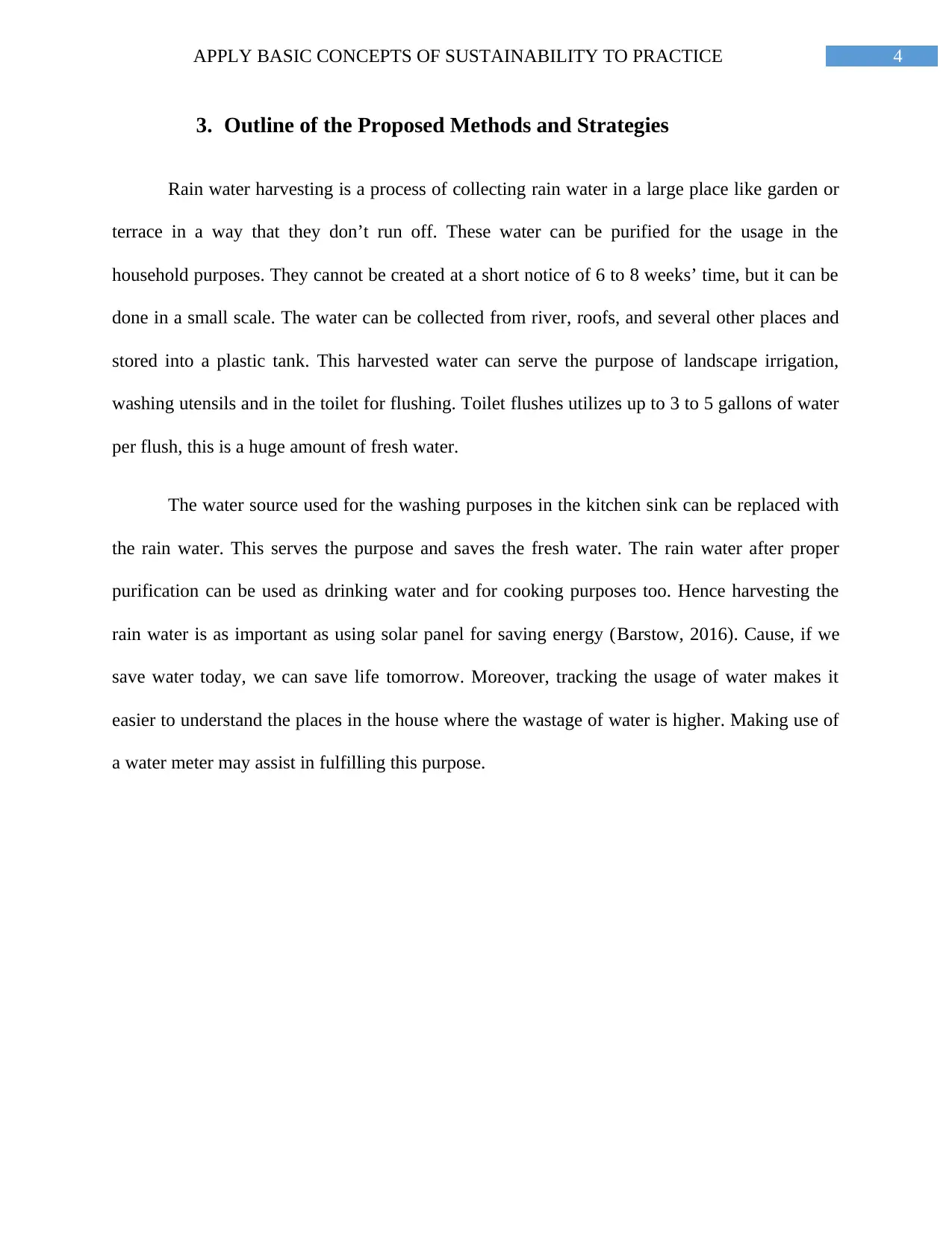
4APPLY BASIC CONCEPTS OF SUSTAINABILITY TO PRACTICE
3. Outline of the Proposed Methods and Strategies
Rain water harvesting is a process of collecting rain water in a large place like garden or
terrace in a way that they don’t run off. These water can be purified for the usage in the
household purposes. They cannot be created at a short notice of 6 to 8 weeks’ time, but it can be
done in a small scale. The water can be collected from river, roofs, and several other places and
stored into a plastic tank. This harvested water can serve the purpose of landscape irrigation,
washing utensils and in the toilet for flushing. Toilet flushes utilizes up to 3 to 5 gallons of water
per flush, this is a huge amount of fresh water.
The water source used for the washing purposes in the kitchen sink can be replaced with
the rain water. This serves the purpose and saves the fresh water. The rain water after proper
purification can be used as drinking water and for cooking purposes too. Hence harvesting the
rain water is as important as using solar panel for saving energy (Barstow, 2016). Cause, if we
save water today, we can save life tomorrow. Moreover, tracking the usage of water makes it
easier to understand the places in the house where the wastage of water is higher. Making use of
a water meter may assist in fulfilling this purpose.
3. Outline of the Proposed Methods and Strategies
Rain water harvesting is a process of collecting rain water in a large place like garden or
terrace in a way that they don’t run off. These water can be purified for the usage in the
household purposes. They cannot be created at a short notice of 6 to 8 weeks’ time, but it can be
done in a small scale. The water can be collected from river, roofs, and several other places and
stored into a plastic tank. This harvested water can serve the purpose of landscape irrigation,
washing utensils and in the toilet for flushing. Toilet flushes utilizes up to 3 to 5 gallons of water
per flush, this is a huge amount of fresh water.
The water source used for the washing purposes in the kitchen sink can be replaced with
the rain water. This serves the purpose and saves the fresh water. The rain water after proper
purification can be used as drinking water and for cooking purposes too. Hence harvesting the
rain water is as important as using solar panel for saving energy (Barstow, 2016). Cause, if we
save water today, we can save life tomorrow. Moreover, tracking the usage of water makes it
easier to understand the places in the house where the wastage of water is higher. Making use of
a water meter may assist in fulfilling this purpose.
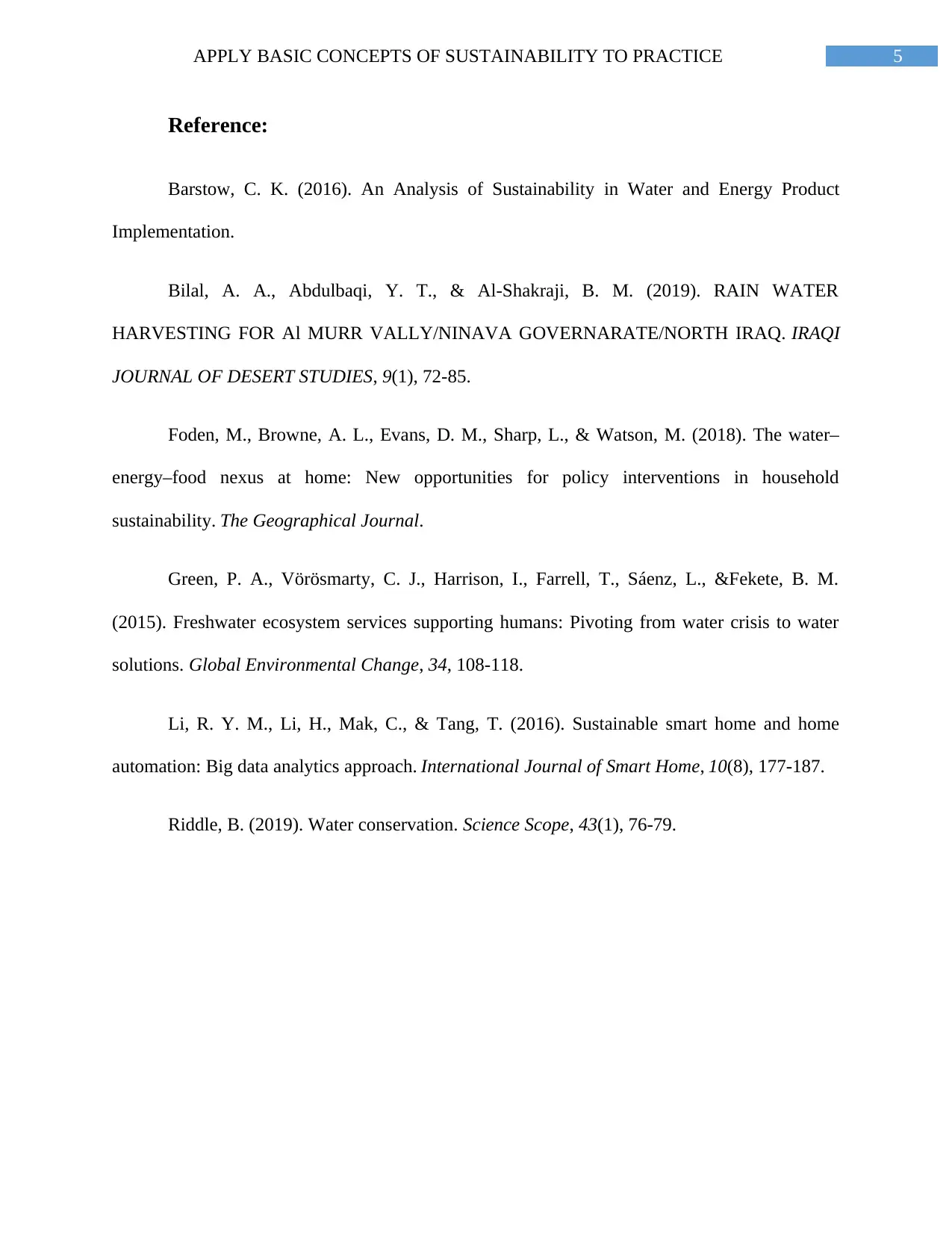
5APPLY BASIC CONCEPTS OF SUSTAINABILITY TO PRACTICE
Reference:
Barstow, C. K. (2016). An Analysis of Sustainability in Water and Energy Product
Implementation.
Bilal, A. A., Abdulbaqi, Y. T., & Al-Shakraji, B. M. (2019). RAIN WATER
HARVESTING FOR Al MURR VALLY/NINAVA GOVERNARATE/NORTH IRAQ. IRAQI
JOURNAL OF DESERT STUDIES, 9(1), 72-85.
Foden, M., Browne, A. L., Evans, D. M., Sharp, L., & Watson, M. (2018). The water–
energy–food nexus at home: New opportunities for policy interventions in household
sustainability. The Geographical Journal.
Green, P. A., Vörösmarty, C. J., Harrison, I., Farrell, T., Sáenz, L., &Fekete, B. M.
(2015). Freshwater ecosystem services supporting humans: Pivoting from water crisis to water
solutions. Global Environmental Change, 34, 108-118.
Li, R. Y. M., Li, H., Mak, C., & Tang, T. (2016). Sustainable smart home and home
automation: Big data analytics approach. International Journal of Smart Home, 10(8), 177-187.
Riddle, B. (2019). Water conservation. Science Scope, 43(1), 76-79.
Reference:
Barstow, C. K. (2016). An Analysis of Sustainability in Water and Energy Product
Implementation.
Bilal, A. A., Abdulbaqi, Y. T., & Al-Shakraji, B. M. (2019). RAIN WATER
HARVESTING FOR Al MURR VALLY/NINAVA GOVERNARATE/NORTH IRAQ. IRAQI
JOURNAL OF DESERT STUDIES, 9(1), 72-85.
Foden, M., Browne, A. L., Evans, D. M., Sharp, L., & Watson, M. (2018). The water–
energy–food nexus at home: New opportunities for policy interventions in household
sustainability. The Geographical Journal.
Green, P. A., Vörösmarty, C. J., Harrison, I., Farrell, T., Sáenz, L., &Fekete, B. M.
(2015). Freshwater ecosystem services supporting humans: Pivoting from water crisis to water
solutions. Global Environmental Change, 34, 108-118.
Li, R. Y. M., Li, H., Mak, C., & Tang, T. (2016). Sustainable smart home and home
automation: Big data analytics approach. International Journal of Smart Home, 10(8), 177-187.
Riddle, B. (2019). Water conservation. Science Scope, 43(1), 76-79.
⊘ This is a preview!⊘
Do you want full access?
Subscribe today to unlock all pages.

Trusted by 1+ million students worldwide
1 out of 6
Your All-in-One AI-Powered Toolkit for Academic Success.
+13062052269
info@desklib.com
Available 24*7 on WhatsApp / Email
![[object Object]](/_next/static/media/star-bottom.7253800d.svg)
Unlock your academic potential
Copyright © 2020–2025 A2Z Services. All Rights Reserved. Developed and managed by ZUCOL.
